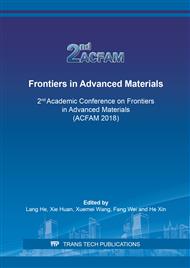[1]
M Zhou, Q Dai, Lecheng Lei, et al. Long Life Modified Lead Dioxide Anode for Organic Wastewater Treatment: Electrochemical Characteristics and Degradation Mechanism. Environmental Science and Technology, 39(2005):363-370.
DOI: 10.1021/es049313a
Google Scholar
[2]
R Lapuente, F Cases. A voltammetric and FTIR-ATR study of the electropolymerization of phenol on platinum electrodes in carbonate mediumInfluence of sulfide [J]. Journal of Electroanalytical Chemistry, 451(1998):163-171.
DOI: 10.1016/s0022-0728(98)00098-9
Google Scholar
[3]
R Amadelli, L Samiolo, A B Velichko, et al. Composite PbO2-TiO2 materials deposited from colloidal electrolyte: Electrosynthesis, and physicochemical properties. Electrochimica Acta, 54(2009):5239-5245.
DOI: 10.1016/j.electacta.2009.04.024
Google Scholar
[4]
Y Dan, H Lu, X Liu, et al. Ti/PbO2+nano-Co3O4 composite electrode material for electrocatalysis of O2 evolution in alkaline solution. International Journal of Hydrogen Energy, 36(2011): 1949-1954.
DOI: 10.1016/j.ijhydene.2010.11.046
Google Scholar
[5]
Z Zhang. Engineering technology of titanium electrode. Beijing: Metallurgical Industry Press, 2003. (in Chinese).
Google Scholar
[6]
I Ivanov, Y Stefanov, Z Noncheva, et al. Insoluble anodes used in hydrometallurgy (Part I): Corrosion resistance of lead and lead alloy anodes. Hydrometallurgy, 57(2000):109-124.
DOI: 10.1016/s0304-386x(00)00097-9
Google Scholar
[7]
Y Lai, L Jiang, J Li, et al. A novel porous Pb-Ag anode for energy-saving in zinc electro-winning(Part I):Laboratory preparation and Properties. Hydrometallurgy, 102(2010):70-83.
DOI: 10.1016/j.hydromet.2010.02.012
Google Scholar
[8]
X Ke, D Tang. Structural and electrochemical features of iridium-based oxide coating on titanim. Heat Treatment of Metals, 33(2008):82-84.
Google Scholar
[9]
Y Shi, H Meng. Electrochemical Behavior of IrO2 Electrodes in the Anodic Electrodeposition of MnO2. Chinese Journal of Chemical Physics, 27(2011):461-467.
Google Scholar
[10]
H T Yang, H R Liu, Z C Guo, et al. Electrochemical behavior of rolled Pb–0.8%Ag anodes. Hydrometallurgy, 140(2013): 144-150.
DOI: 10.1016/j.hydromet.2013.10.003
Google Scholar
[11]
Y Zhang, B Chen, Z Guo, et al. Corrosion resistance of electrodeposited Al/Pb-Ag anode during zinc electrowinning. Chinese Journal of Applied Chemistry, 30(2013):458-462.
DOI: 10.3724/sp.j.1095.2013.20264
Google Scholar
[12]
D Zhou, L Gao. Effect of electrochemical preparation methods on structure and properties of PbO2 anodic layer. Electrochimica Acta, 53(2007):2060-2064.
DOI: 10.1016/j.electacta.2007.09.005
Google Scholar
[13]
Y Xia, Q Dai, J Chen. Electrochemical degradation of aspirin using a Ni doped PbO2 electrode. Journal of Electroanalytical Chemistry, 744(2015):117-125.
DOI: 10.1016/j.jelechem.2015.01.021
Google Scholar
[14]
S P Li, Z Hu, H L Cao. Preparation and characterization of neodymium doped Ti-based SnO2/Sb electrocatalytic electrodes. Journal of the Chinese Society of Rare Earths, 26(2008): 291-295.
Google Scholar
[15]
Y Dong. A Study of Ti/SnO2-Sb/PbO2 Electrode Passivation during the Electrochemical Oxidation. Master's Degree Thesis of Jilin University, China, 2007. (in Chinese).
Google Scholar
[16]
L Li, Z Huang, X Fan, et al. Preparation and Characterization of a Pd modified Ti/SnO2-Sb anode and its electrochemical degradation of Ni-EDTA, Electrochimica Acta, 231(2017):354-362.
DOI: 10.1016/j.electacta.2017.02.072
Google Scholar
[17]
H Yang, B Chen, Z Guo, et al. Effects of current density on preparation and performance of Al/conductive coating/a-PbO2-CeO2-TiO2/β-PbO2-MnO2-WC-ZrO2 composite electrode materials. Transactions of Nonferrous Metals Society of China, 24(2014):3394-3404.
DOI: 10.1016/s1003-6326(14)63482-8
Google Scholar
[18]
R D Xu, L P Huang, J F Zhou, et al. Effects of tungsten carbide on electrochemical properties and microstructural features of Al/Pb-PANI-WC composite inert anodes used in zinc electrowinning. Hydrometallurgy, 22(2012):1693-1700.
DOI: 10.1016/j.hydromet.2012.04.012
Google Scholar
[19]
Y Lai, Y Li, L Jiang, et al. Electrochemical behaviors of co-deposited Pb/Pb–MnO2, composite anode in sulfuric acid solution-Tafel and EIS investigations. Journal of Electroanalytical Chemistry, 671(2012):16-23.
DOI: 10.1016/j.jelechem.2012.02.011
Google Scholar
[20]
H Ning, Y Xin, L Xu, et al. Properties of IrO2-Ta2O5 Coated Titanium Anodes Modified with Graphene. Rare Metal Materials and Engineering, 45(2016):946-951.
Google Scholar
[21]
F Lian, Y Xin, B Ma, et al.Effect of Carbon Nanotubes on Anodic Properties of Ti/Ru-Ir-Sn Oxides. Journal of Electrochemistry, 21(2015):375-381.
Google Scholar
[22]
J M Hu, H M Meng, J Q Zhang, et al. Degradation mechanism of long service life Ti/Ir-TaO oxide anodes in sulphuric acid. Corrosion Science, 44(2002):1655-1668.
DOI: 10.1016/s0010-938x(01)00165-2
Google Scholar
[23]
L Xu, Y Xin, J Wang. A comparative study on IrO2-Ta2O5 coated titanium electrodes prepared with different methods. Electrochimica Acta, 54(2009):1820-1825.
DOI: 10.1016/j.electacta.2008.10.004
Google Scholar
[24]
B Chen, Z Guo, H Huang, et al. Effect of the current density on electrodepositing alpha-lead dioxide coating on aluminum substrate. Acta Metallurgica Sinica (English Letters), 22(2009):373-382.
DOI: 10.1016/s1006-7191(08)60111-8
Google Scholar
[25]
Débora V. Franco, Leonardo M. Da Silva, Wilson F. Jardim, et al. Influence of the electrolyte composition on the kinetics of the oxygen evolution reaction and ozone production processes.Journal of the Brazilian Chemical Society, 17( 2006):446-757.
DOI: 10.1590/s0103-50532006000400017
Google Scholar
[26]
V A Alves, L A D Silva, J F C Boodts. Surface characterisation of IrO2/TiO2/CeO2, oxide electrodes and Faradaic impedance investigation of the oxygen evolution reaction from alkaline solution. Electrochimica Acta, 44(1998):1525-1534.
DOI: 10.1016/s0013-4686(98)00276-x
Google Scholar
[27]
H T Yang, H R Liu, Z C Guo, et al. Electrochemical behavior of rolled Pb–0.8%Ag anodes. Hydrometallurgy, 140(2013):144-150.
DOI: 10.1016/j.hydromet.2013.10.003
Google Scholar
[28]
U Casellato, S Cattarin, M Musiani. Preparation of porous PbO2, electrodes by electrochemical deposition of composites. Electrochimica Acta, 48(2003):3991-3998.
DOI: 10.1016/s0013-4686(03)00527-9
Google Scholar
[29]
Junfeng Gui, Liangxing Jiang, Xiaocong Zhong, et al. Effects of Ag and RE contents on electrochemical performance of PbAgRE alloy anode. The Chinese Journal of Nonferrous Metals, 25(2015):111-118.
Google Scholar
[30]
Maolan Zhu, Tao Tu, Gensong Zhu, et al. Influence of Gd on properties of Pb based anode for nonferrous electrowinning. The Chinese Journal of Nonferrous Metals, 24(2014):2821-2826.
Google Scholar
[31]
Xiaocong Zhong, Liangxing Jiang, Xiaojun Lu, et al. Effects of chloride ion on the electrochemical behavior of Pb-Ag-RE alloy anode. Acta Metallurgica Sinica, 3(2015):378-384.
Google Scholar
[32]
Y H Shi, H M Meng, D B Sun, et al. Effect of SbOx+SnO2 intermediate layer on the properties of Ti-based MnO2 anode. Acta Physico-Chimica Sinica, 23(2007):1553-1559.
Google Scholar
[33]
Y Zheng, W Su, S Chen, et.al. Ti/SnO2–Sb2O5–RuO2/α-PbO2/β-PbO2 electrodes for pollutants degradation, Chemical Engineering Journal, 174(2011):304-309.
DOI: 10.1016/j.cej.2011.09.035
Google Scholar
[34]
W Yang, H Wang, F Fu, Preparation and performance of Ti/Sb-SnO2/β-PbO2 electrode modified with rare earth, Rare Metal Materials and Engineering, 39(2010):1215-1218.
Google Scholar
[35]
Yongchang Huang, Houlong Chen. Study on the anodic reaction of chloring evolution on Ti/β-PbO2 electrode. Chinese Journal of Applied Chemistry, 7(1990):25-29.
Google Scholar


